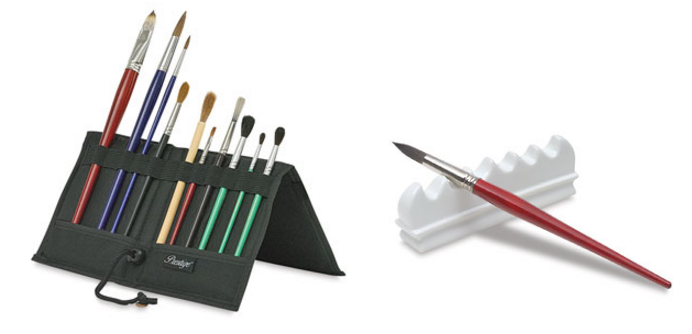If you always use acrylic paint, you know that this is the type of paint that dries very easily. Whatever you do, always keep your art brush moist or wet. Do not let paint dry on your brush during or after using it. Make it a habit too to wash it with warm soap and water after an art session for a thorough clean.
Always have a cup of water on standby when painting with acrylic to avoid creating crusty stumps on your art brushes. Remember: the longer you allow paint to dry on your art brush, the harder it becomes to remove it.
However, if your art brushes have turned very crusty, don't throw it away still! Use it in an expressionistic way or any artwork that do not require intricate precision or gentle strokes.
What is a ferrule?
Why should you try not get paint on it? When paint gets on the ferrule, paint usually turns into a large blob between it and the strands, resulting into brush strands that are too spread apart and frayed. Make it a habit to dip your paint only on the strands or immediately clean your brush before it hardens.
It is not enough to have a cup of water for rinsing your art brush on standby. Remember never to leave your brush with all the strands facing head down in your cup. An art brush with bent and frayed strands will definitely go wonky, and you don't want your artwork to be compromised simply because of an art brush mishandling.
Even a stiff brush should not be forced down inside a cup of water. It will ruin its integrity and you don't want that to happen!
If you're painting quite a big artwork and you are using more than one brush at the same time, have a rack on your work desk so your art brushes can rest properly while waiting for its turn. Check out some brush racks you can use below.
There's truly a lot of TLC when it comes to preserving good ol' art brushes.
If your art brush set comes with a preserver kit, use it regularly to prolong the lifespan of your vital art instruments.
They say you can also use regular shampoo together with warm water to clean art brushes so you might want to give that a spin too. Some even use dish washing soap and ammonia-based glass cleaner for stubborn stumps of water-soluble paints.
And for really stubborn paint, use a brush to clean your brush! This gives your old toothbrushes another round of practical use before retiring it for good.
Give your art brushes the proper rest it deserves when not in use. Make sure they are stored vertically head-side-up or horizontally or else, they can become deformed. Some artists have their brushes rolled up in a canvas sleeve with small individual pockets for each art brush. Do not pack them too tightly.




 RSS Feed
RSS Feed
